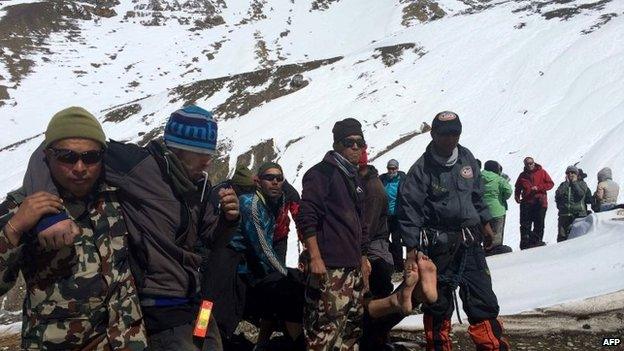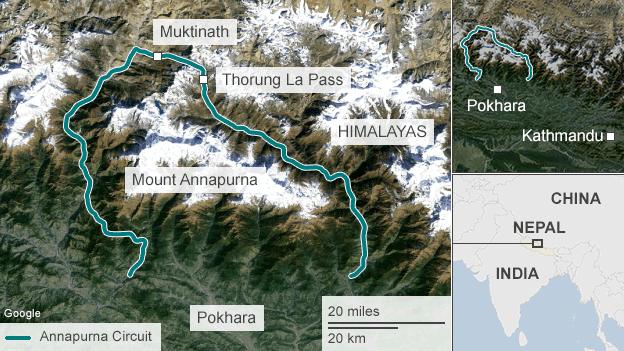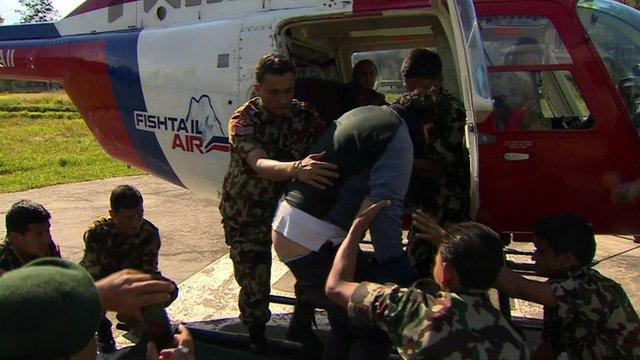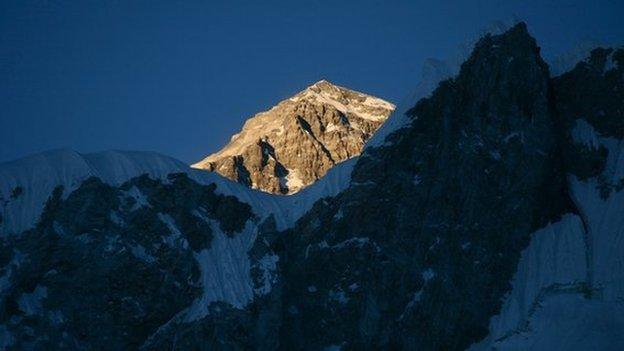Nepal blizzards: Rescue teams reach Thorung La pass
- Published
As Andrew North reports, rescue teams are continuing to look for survivors
Search teams in Nepal say they have rescued 60 more trekkers from the Annapurna Circuit, after a deadly storm hit the popular Himalayan route.
Tourism Minister Deepak Amatya told the BBC a total of 282 people had been rescued from the mountain ranges.
On Friday, officials said good weather let troops and helicopters reach the Thorung La pass, the high point of the Annapurna Circuit, for the first time.
At least 29 people are known to have died in the disaster.
It is on course to be the worst single trekking and climbing disaster Nepal has seen.
'Neck deep in snow'
Many of the dead are thought to have left the Thorung La pass to try to flee the storm.
They are believed to have left the shelter there and tried to descend, but instead got lost and froze in the open. The bad weather hit a resting place 4,500m (14,800ft) above sea level, not far below the Thorung La pass.
Paul Sherridan: "I looked at a boy and his face was frozen"
Nineteen bodies have so far been recovered, but 10 are still lying in a remote part of Manang district, Mr Amatya said.
Nepalese, Israeli, Canadian, Indian, Slovak and Polish trekkers are among those who perished.
Officials say the death toll is likely to rise further, with many bodies still to be recovered from the snow.
More than 200 people were rescued from the route on Thursday.

Nepal Army personnel have been helping in the rescue
Three of those rescued on Friday at the Thorung La pass are in a critical condition and are being treated at a health facility in Mustang.
Some of the trekkers had sought shelter in a temple, Surya Bahadur, a police officer from the Dolpa district told Reuters.
"Some of the foreign tourists were sitting in the temple for the last two days... they had very little food to eat and they were sharing blankets," he said.
Mustang governor Baburam Bhandari said that rescuers found one Israeli trekker who had been trapped in snow up to his neck for 48 hours and took him to hospital.

At the scene - Navin Singh Khadka, Pokhara
Helicopters have been flying in and out of this major tourist hub as search and rescue operations continue in the nearby Annapurna region
Some injured trekkers have been admitted to local hospitals from the Annapurna and Dhaulagiri mountain ranges.
Kumar Tamang, a trekking guide who survived avalanches near a pass between Mustang and Dolpa districts on Monday, said he and three others in his group were lucky to be alive.
"There were two avalanches within an hour," he told the BBC from his hospital bed.
"We all managed to survive the first one and took shelter inside a tent... When the second one hit, we all were buried under the snow and only four of us managed to get out."

Nepal's Prime Minister Sushil Koirala said in a statement that the deaths were "extremely tragic at a time when worldwide weather updates are available every second".
"I want to assure that the government will make efforts to establish early warning centres for weather in the important spots across the country, especially in the Himalayan areas and along rivers," he added.


What is the Annapurna Circuit?
Roughly 241km (150 miles), takes around three weeks to complete
Described as "the best long distance trek in the world"
Known as the "apple pie" circuit due to the baked goods offered by tea houses along the route
Ascends to 5,416m (17,776ft) at the Thorung La Pass
Opened to tourists in 1977 after conflicts between guerrillas and the Nepalese army were resolved
Circuit passes Mount Annapurna, world's 10th highest mountain and one of the most dangerous

This has been a particularly deadly year for Nepal's trekking and mountaineering industry, which brings in huge revenues to Nepal, one of the world's poorest countries.
An avalanche on Mount Everest in April killed 16 Sherpa guides and resulted in a significant drop in the number of expeditions to the world's highest peak.
The latest disaster comes at the height of the trekking period. Thousands of tourists head to Nepal in October to enjoy its mountain passes and pristine beauty. But this unexpected heavy snowfall caught the trekkers off guard.
Nepal's high peaks attract some of the world's best climbers - but trekking is generally safe and appeals to masses of ordinary enthusiasts.

- Published17 October 2014
![Sgt Paul Sherridan [left] and Steve Wilson in the Himalayas](https://ichef.bbci.co.uk/ace/standard/624/mcs/media/images/78303000/jpg/_78303311_sherridan2.jpg)
- Published17 October 2014

- Published25 April 2014
